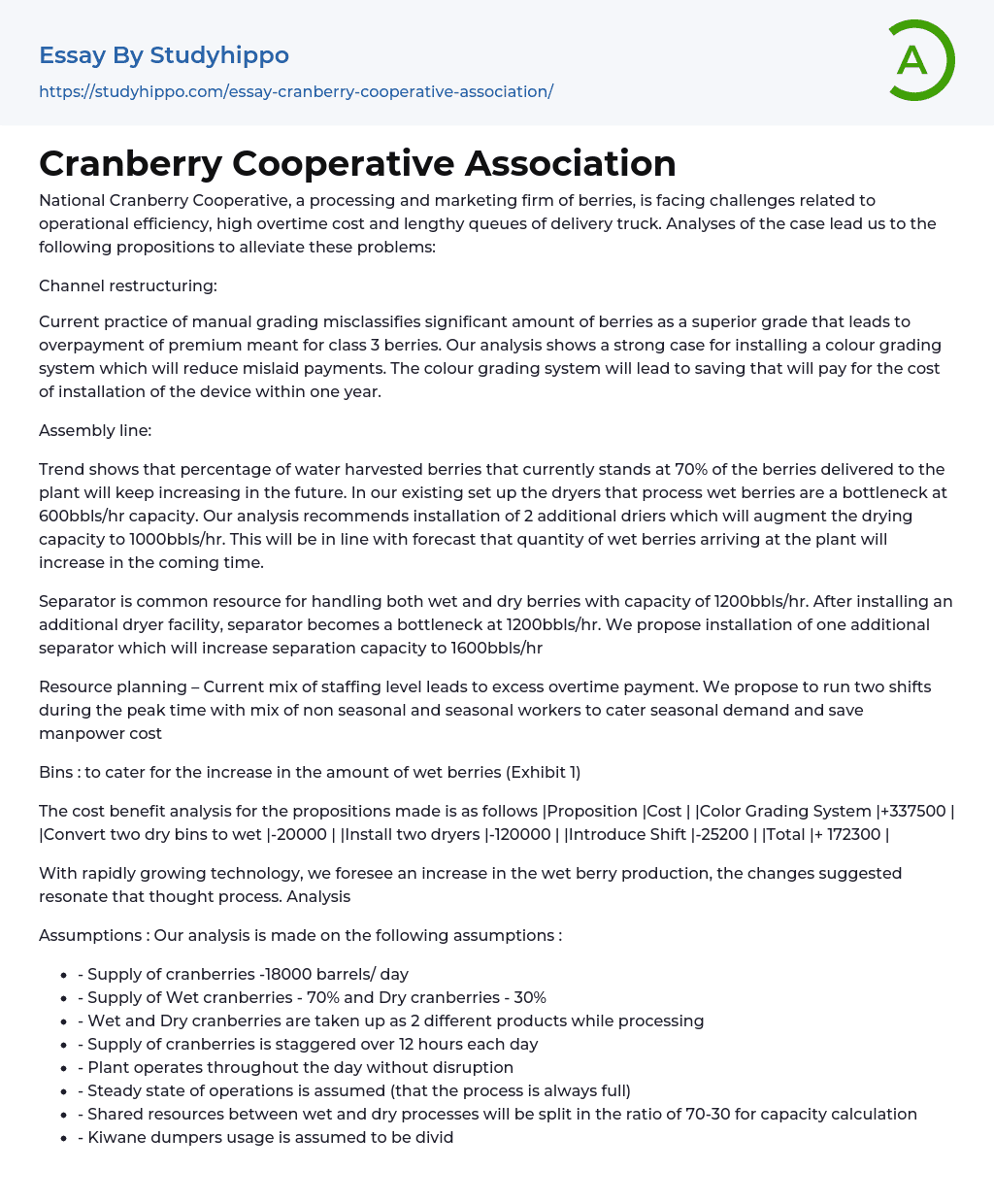In order to tackle operational efficiency issues, high overtime expenses, and lengthy delivery truck queues, the National Cranberry Cooperative should adopt the proposed solutions derived from our analysis of the case.
Channel restructuring:
Current manual grading practices often result in a misclassification of a large number of berries as superior grade, leading to excessive payment for class 3 berries. Our analysis demonstrates a compelling argument for adopting a colour grading system, which would minimize the occurrence of such overpayment. By implementing this system, significant savings could be made within a year to cover the cost of installing the device.
Assembly line:
The current percentage of water harvested berries that are delivered to the plant is 70%, and this perce
...ntage is expected to increase in the future. However, our dryers have a capacity of processing only 600bbls/hr of wet berries, which has become a bottleneck in our operation. To address this issue, it is recommended to install 2 additional dryers, increasing the drying capacity to 1000bbls/hr. This upgrade aligns with the projected increase in the quantity of wet berries arriving at the plant.
The separator is a resource used for handling both wet and dry berries. Its processing capacity is 1200bbls/hr but after adding a new dryer facility, it becomes the limiting factor at this capacity. To resolve this problem, we recommend installing an additional separator to increase the separation capacity to 1600bbls/hr.
Resource planning proposal: To address increased demand during seasonal periods and reduce overtime payments, we propose implementing two shifts by combining both non-seasonal and seasonal workers.
View entire sample
justify;">Bins: designed to accommodate the growing quantity of moist berries (Exhibit 1)
The cost benefit analysis for the proposed actions is as follows:
| Proposition | Cost |
|---|---|
| Color Grading System | +337500 |
| Convert two dry bins to wet | |
| -20000 | |
| Install two dryers | -120000 |
| Total | Td>+172300+
The suggested changes in the analysis align with our anticipation of an increase in wet berry production due to rapidly advancing technology.
Our analysis is based on the following assumptions:
- - Supply of cranberries -18000 barrels/ day
- - Supply of Wet cranberries - 70% and Dry cranberries - 30%
- - Wet and Dry cranberries are taken up as 2 different products while processing
- - Supply of cranberries is staggered over 12 hours each day
- - Plant operates throughout the day without disruption
- - Steady state of operations is assumed (that the process is always full)
- - Shared resources between wet and dry processes will be split in the ratio of 70-30 for capacity calculation
- - Kiwane dumpers usage is assumed to be divided in 3 being allocated to wet cranberries and 2 allocated to dry cranberries
- - All
the common holding bins will be used for wet cranberries
The exhibit 1 shows the process flow diagram of cranberry processing, and exhibit 2 displays the calculation of process capacity and utilization. It is possible to switch the common process smoothly from one type of cranberry processing to another.
The colour grading system was found to inaccurately categorize grad 2b berries as class 3 berries in 50% of cases, resulting in suppliers not receiving the appropriate premium. Our analysis of a business case for implementing a new colour grading system is as follows: Premium Paid = $1.5 per barrel for Type 3.
In 1995, there were 450,000 barrels of berries that could potentially be categorized as grade 3 berries. Out of these, 50 percent (225,000 barrels) were wrongly identified, resulting in an excessive payment of $337,500. The installation of a light meter, costing $40,000 and taking 6 months to set up, is necessary. An operator is also needed to run the light meter, but since they will be paid the same as the Chief Berry receiver, there will be no extra cost in operating the machine.
- Chief Executive Officer essays
- Convenience Store essays
- Firm essays
- Training And Development essays
- Unilever essays
- Variable Cost essays
- Virgin Group essays
- Bargaining essays
- Entity essays
- Pest analysis essays
- Qualities essays
- John Locke essays
- 9/11 essays
- A Good Teacher essays
- A Healthy Diet essays
- A Modest Proposal essays
- A&P essays
- Academic Achievement essays
- Achievement essays
- Achieving goals essays
- Admission essays
- Advantages And Disadvantages Of Internet essays
- Alcoholic drinks essays
- Ammonia essays
- Analytical essays
- Ancient Olympic Games essays
- APA essays
- Arabian Peninsula essays
- Argument essays
- Argumentative essays
- Art essays
- Atlantic Ocean essays
- Auto-ethnography essays
- Autobiography essays
- Ballad essays
- Batman essays
- Binge Eating essays
- Black Power Movement essays
- Blogger essays
- Body Mass Index essays
- Book I Want a Wife essays
- Boycott essays
- Breastfeeding essays
- Bulimia Nervosa essays
- Business essays
- Business Process essays
- Canterbury essays
- Carbonate essays
- Catalina de Erauso essays
- Cause and Effect essays




